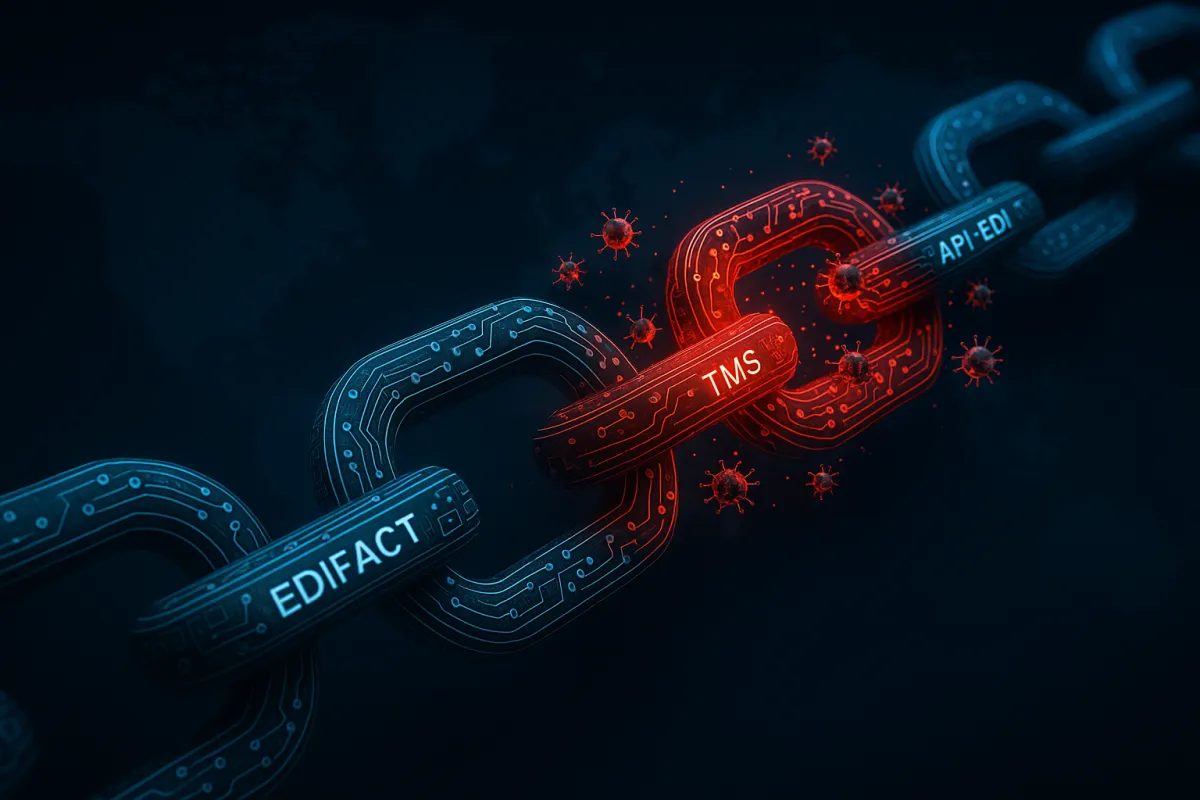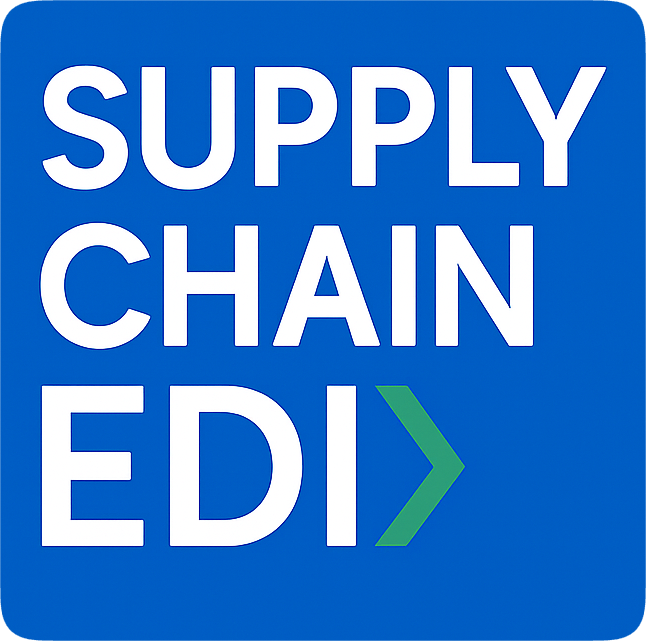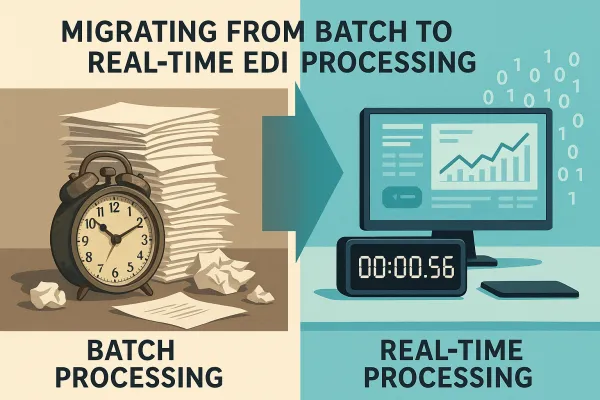The Complete EDI Third-Party Cyber Risk Assessment Framework: How to Prevent Supply Chain Attacks That Have Doubled in 2025

Recent Cyble research documents an alarming reality: supply chain attacks have averaged 26 incidents monthly since April 2025, doubling the rate from early 2024. For EDI managers overseeing hundreds of trading partner connections, this represents more than just another security statistic. Third-party supply chain breaches now cost an average of $4.91 million and take significantly longer to detect and contain than direct attacks.
Your EDI network creates dozens of trusted pathways into your organization through AS2 connections, SFTP channels, and API integrations. Each trading partner becomes a potential attack vector, and supply chain attacks doubled beginning in April 2025, with third-party breaches comprising 35.5% of all incidents. Traditional perimeter defenses offer little protection when attackers compromise your most trusted suppliers.
The 2025 Supply Chain Attack Crisis: Why Traditional EDI Security Falls Short
The numbers tell a stark story. According to the Verizon Data Breach Investigations Report, 30% of all data breaches now involve a third-party, a 100% increase year over year, while the global average cost of a data breach reached $4.44 million. But these statistics only scratch the surface of what's happening in EDI environments.
Consider how attackers exploit EDI trust relationships. Your organization has spent months or years establishing secure AS2 connections with key suppliers. You've exchanged certificates, configured firewalls, and validated data flows. This very trust becomes the weakness. Supply chain cyber attacks exploit the implicit trust between businesses and their vendors, leveraging a single vulnerable link to infiltrate multiple organizations.
The transportation management sector illustrates this vulnerability perfectly. TMS providers like MercuryGate, Descartes, and nShift process millions of EDI transactions daily from thousands of carriers and shippers. A compromise at any major TMS provider instantly affects their entire customer base. Recent supply chain incidents have resulted in operational disruption impacting key systems, including distribution, licensing, transaction systems, and API infrastructure.
What makes 2025 different? Ransomware, data theft, and zero-day exploits drive the ongoing surge in supply chain attacks. Sophisticated groups specifically target EDI systems because they know these connections bypass traditional security monitoring. Your EDI traffic flows directly into ERP systems, often with elevated privileges and minimal oversight.
Understanding EDI-Specific Third-Party Attack Vectors
EDI networks present unique attack surfaces that traditional cybersecurity frameworks don't adequately address. EDI systems frequently rely on the cloud and third-party providers, introducing potential weak spots where data breaches, cyberattacks, and other malicious attempts by bad actors pose risks to confidentiality.
Credential stuffing attacks against VAN providers represent a growing threat. Many organizations use shared credentials across multiple EDI connections, creating a domino effect when one set gets compromised. Attackers exploit this by targeting VAN providers like SPS Commerce or TrueCommerce, knowing that successful penetration gives them access to hundreds of downstream customers.
API-EDI hybrid vulnerabilities compound these risks. Modern integrations often blend traditional EDI protocols with REST APIs for real-time data exchange. This creates new attack vectors where API authentication tokens can be compromised, providing attackers with both EDI access and broader system privileges.
Transportation management systems exemplify these vulnerabilities. When carriers integrate with platforms like Transporeon or BluJay Solutions, they establish multiple connection types: traditional EDI for invoicing, APIs for real-time tracking, and web portals for exception management. Each connection point creates potential exposure, yet many organizations lack visibility into all these touchpoints.
The trust model inherent in EDI exacerbates these risks. Whenever business partners exchange electronic documents such as purchase orders or invoices, there is always some risk that confidential information could be compromised by a third party. Your firewall allows EDI traffic from trusted partners, but how do you verify that traffic actually originates from your partner and hasn't been intercepted or manipulated?
The 7-Phase EDI Third-Party Risk Assessment Framework
Effective EDI third-party cyber risk assessment requires a systematic approach that goes beyond traditional vendor questionnaires. This seven-phase framework addresses the unique characteristics of EDI environments and emerging threat vectors.
Phase 1: Comprehensive EDI Connection Inventory
Start by cataloging every EDI connection, not just the obvious ones. Include VAN connections, direct AS2 links, SFTP channels, API integrations, and web-based EDI portals. Many organizations discover forgotten connections during this phase, legacy links to former suppliers that still maintain active credentials.
Document connection types, protocols, authentication methods, and data volumes for each trading partner. Pay special attention to connections that bypass your primary EDI solution, including spreadsheet-based exchanges and email-based document transfers that might not be formally recognized as EDI.
Phase 2: Trading Partner Criticality Classification
Conduct thorough evaluations covering data, systems, partners, processes, and laws to identify protection gaps, quantify dangers, and prioritize issues. Classify vendors into tiers based on data sensitivity, transaction volume, and business impact rather than just revenue.
Tier 1 suppliers typically include those with access to financial data, those processing high-volume transactions, or those integrated with critical systems like inventory management or production planning. Tier 2 might include moderate-volume suppliers or those with limited data access. Tier 3 encompasses low-risk, infrequent trading partners.
Phase 3: Technical Security Architecture Assessment
Evaluate each connection's technical security controls. EDI security relies heavily on strong authentication and authorization mechanisms, with recommended best practices including multi-factor authentication and role-based access control. Verify encryption standards, certificate management practices, and network segmentation.
For TMS integrations, examine how carriers authenticate to your systems. Do they use shared credentials, certificate-based authentication, or modern OAuth tokens? How frequently are credentials rotated, and what happens when personnel changes occur at the carrier?
Phase 4: Data Flow Analysis and Exposure Mapping
Map exactly what data flows through each EDI connection and where it goes within your organization. This often reveals surprising exposures, such as purchase orders that include confidential pricing information or shipping documents that contain customer personal data.
Document data retention periods, backup procedures, and deletion practices for each trading partner. Many organizations discover they're retaining sensitive data far longer than necessary or sharing it with more systems than originally intended.
Phase 5: Compliance Verification
Regular compliance audits help verify that EDI systems meet industry-specific regulations such as HIPAA in healthcare, GDPR for data protection, and PCI DSS for financial transactions, including evaluation of vendors' compliance. Don't just review certificates; verify actual implementation.
For SOC 2 reports, examine the scope carefully. Many EDI providers have SOC 2 Type II reports that don't cover all systems used for your specific integration. ISO 27001 certification similarly may not extend to all relevant business units or geographic locations.
Phase 6: Incident Response Capability Evaluation
Test each trading partner's incident response capabilities, not just their documented procedures. How quickly can they identify a compromise? Do they have procedures for notifying trading partners? Can they isolate affected systems without disrupting legitimate traffic?
Evaluate communication channels for security incidents. Email-based notifications may be inadequate for time-sensitive breaches. Consider dedicated security contact methods and escalation procedures.
Phase 7: Continuous Monitoring Implementation
Continuous monitoring and intrusion detection systems allow organizations to quickly identify and respond to security threats in real time by analyzing network traffic, security logs, and user activity for early detection. Implement monitoring that's specific to EDI traffic patterns and can detect anomalies in transaction volumes, timing, or content.
Establish baseline behaviors for each trading partner connection. Unusual access patterns, off-hours activity, or unexpected data volumes can indicate compromise. Modern SIEM solutions can be configured to recognize these EDI-specific threat indicators.
Critical Security Controls for EDI Trading Partner Networks
Traditional network security controls often prove inadequate for EDI environments due to the unique trust relationships and data exchange patterns. Implement robust security measures including strong encryption and multi-factor authentication with regular security audits as baseline requirements.
Multi-factor authentication for EDI connections goes beyond simple username and password combinations. Certificate-based authentication provides stronger security for AS2 connections, while API-based integrations should use OAuth 2.0 with time-limited tokens. For web-based EDI portals, implement adaptive authentication that considers login patterns, device characteristics, and geographic locations.
Network segmentation for EDI traffic creates crucial isolation boundaries. Establish dedicated network segments for EDI connections, separate from general internet access and internal corporate networks. This segmentation should extend to TMS integrations and carrier connectivity, ensuring that a compromise in one area can't spread throughout your infrastructure.
Real-time monitoring and anomaly detection specifically tuned for EDI patterns can identify threats that traditional security tools miss. Normal EDI traffic follows predictable patterns: purchase orders during business hours, shipping notifications triggered by warehouse events, invoices following delivery confirmations. Deviations from these patterns often indicate problems.
For transportation management systems, implement specific controls around carrier connectivity. Platforms like Cargoson, Oracle Transportation Management, and other TMS solutions should enforce certificate validation, maintain audit logs of all data exchanges, and provide real-time monitoring of carrier access patterns.
Encrypted data validation extends beyond basic transmission encryption. Verify that trading partners encrypt data at rest, not just in transit. For cloud-based EDI providers, understand their encryption key management practices and ensure you maintain appropriate control over your own data.
Automated Monitoring and Threat Detection for EDI Systems
SIEM integration for EDI transaction monitoring requires specialized configuration to handle the unique characteristics of electronic data interchange. Standard SIEM rules designed for web traffic or email systems often generate false positives when applied to EDI environments.
Behavioral analysis for unusual data patterns proves particularly effective in EDI environments. Establish baselines for transaction volumes, document types, and timing patterns for each trading partner. A supplier who normally sends 50 purchase orders per day suddenly transmitting 500 orders might indicate either a legitimate business change or a potential security incident.
Automated alerts for failed authentication attempts need careful tuning in EDI environments. Unlike interactive user sessions, EDI connections often retry failed transmissions multiple times as part of normal error handling. Configure alerts to trigger on unusual failure patterns rather than simple failure counts.
Integration with threat intelligence feeds can provide early warning of compromised trading partners. Commercial threat intelligence services increasingly include data about supply chain compromises, allowing you to proactively assess partners who may have been affected by recent incidents.
For transportation management platforms including BluJay Solutions, Descartes, and nShift, implement monitoring that tracks not just successful transactions but also connection attempts, authentication failures, and unusual access patterns. These systems often process thousands of transactions daily from hundreds of carriers, making manual monitoring impractical.
Incident Response Planning for EDI Supply Chain Breaches
EDI supply chain incidents require specialized response procedures that differ significantly from traditional cybersecurity incidents. The interconnected nature of EDI networks means that a breach at one trading partner can quickly cascade through multiple organizations.
Rapid isolation procedures for compromised EDI connections must balance security with business continuity. Unlike web applications that can be taken offline temporarily, EDI connections often support time-sensitive business processes. Develop procedures for quickly switching to backup connections or alternative communication methods.
Communication protocols with affected trading partners should be established before incidents occur. During a crisis, determining how to securely communicate with potentially compromised partners becomes challenging. Establish out-of-band communication channels and predefined contact procedures.
Data breach notification requirements vary significantly depending on the types of data exchanged through EDI connections. HIPAA compliance requires strict privacy and security rules for any EDI transactions involving patient information, with specific security measures, regular risk assessments, and ensuring all EDI partners are also HIPAA-compliant. Financial data may trigger PCI DSS notification requirements, while personal information could invoke GDPR obligations.
Recovery and restoration procedures for EDI systems need specific consideration for data integrity. Unlike other systems where restoring from backup is straightforward, EDI systems must maintain transaction sequencing and avoid duplicate processing. Document procedures for validating data integrity after restoration and reconciling any missed transactions.
For transportation management systems, develop specific procedures for handling carrier-related incidents. If a major carrier's systems are compromised, you may need to temporarily suspend automated load tendering while maintaining manual communication channels for urgent shipments.
Legal and Compliance Considerations for EDI Third-Party Risk
GDPR implications for international EDI data flows create complex compliance requirements that many organizations underestimate. Regular compliance audits verify that EDI systems meet industry-specific regulations such as GDPR for data protection, but the interconnected nature of supply chains means data often crosses multiple jurisdictions.
When your EDI connections include European suppliers or customers, personal data protection requirements extend to your entire trading partner network. This includes not just obvious personal data like employee information but also potentially identifying information embedded in purchase orders, shipping documents, or product specifications.
SOX compliance for financial EDI transactions requires specific attention to trading partner controls. Public companies must demonstrate that their financial reporting controls extend to third-party systems that provide data for financial statements. This includes EDI connections used for revenue recognition, inventory valuation, or accounts payable processing.
Industry-specific requirements add additional layers of complexity. Automotive suppliers must comply with TISAX requirements, healthcare organizations face HIPAA obligations, and financial services companies deal with various banking regulations. Each industry's requirements affect how EDI data can be processed, stored, and transmitted.
Contractual security requirements and liability allocation require careful attention in EDI agreements. Standard trading partner agreements often lack specific cybersecurity provisions, leaving both parties exposed to unclear responsibilities during incidents. Modern agreements should address data breach notification timeframes, liability limits for third-party attacks, and specific security control requirements.
For TMS vendors and EDI providers, regulatory requirements continue evolving. The EU's NIS2 directive affects many logistics providers, while various national cybersecurity regulations impose additional obligations on supply chain participants.
The strategic imperative for 2025 and beyond is the shift from awareness to readiness, requiring a proactive, resilience-focused security program built on principles of zero trust, radical transparency, and continuous verification. The traditional approach of annual vendor assessments and static security controls no longer suffices in an environment where supply chain attacks have doubled and continue accelerating.
Your EDI third-party risk assessment isn't just another compliance checkbox. With global annual costs of software supply chain attacks predicted to reach $60 billion in 2025, this framework represents a practical defense against the most significant threat facing modern supply chains. Start with Phase 1 tomorrow: you likely have more EDI connections than you realize, and each one represents both business value and potential risk in today's threat landscape.





